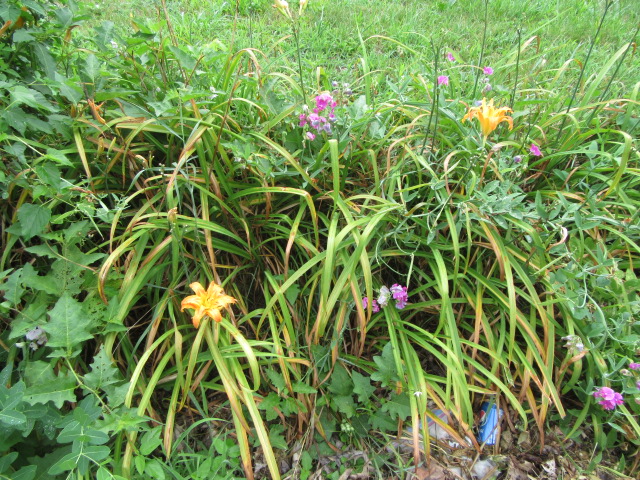
Hello everyone! I hope you are all doing well. We had more rain, up to 3 3/4″ through Thursday with more in the forecast. A few days ago I was trimming the ditch in front of what I always call the “other yard.” It is where my grandparent’s house was and where the garden is. Well, I didn’t plant the garden this year but that is beside the point. The part of the ditch in front of where the garden normally is can get a little wild. I can’t mow it with the riding mower because the ditch was cut too deep. I have mowed the front part with the riding mower in the past but it keeps getting hung up. Then I have to turn it off and pick it up and move it over. I can mow with the push mower, but my son finally moved out and he needed it for his yard. He hasn’t brought it back yet so I have to use the trimmer… Anyway, when I got to the mailbox I stopped dead in my tracks because of what showed up… Then I found more behind the mailbox. I continued trimming until the battery ran out of power then I went to the house to get the camera…
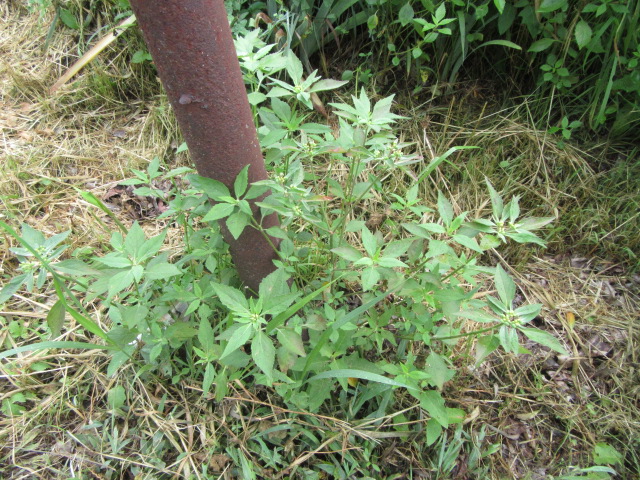
Euphorbia davidii (David’s Spurge) on 7-26-22, #901-17.
I was pretty excited I found what I “thought” was Euphorbia dentata (Green Poinsettia) right in the ditch!
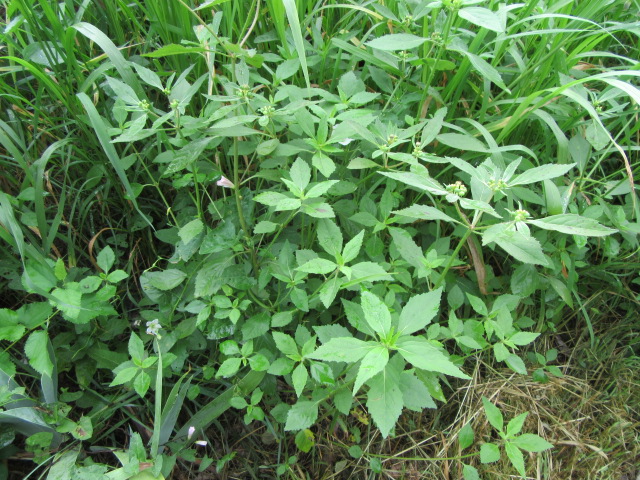
Euphorbia davidii (David’s Spurge) on 7-26-22, #901-18.
Then I saw more behind the mailbox! Look how tall they are! It had been a while since I trimmed this part of the ditch, so perhaps I shouldn’t have been that surprised.
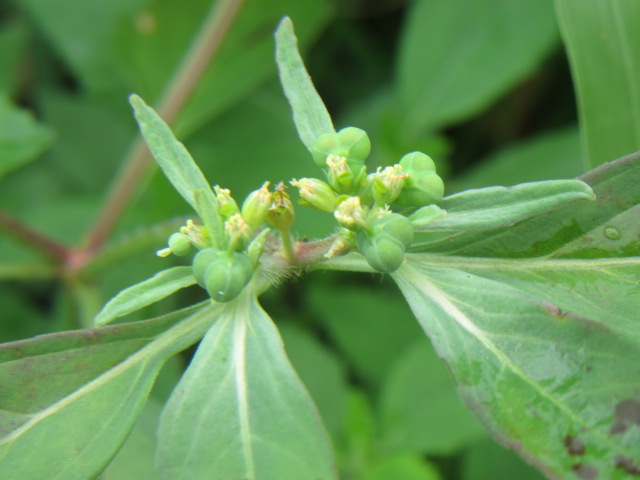
Euphorbia davidii (David’s Spurge) on 7-26-22, #901-19.
There was fruit and what was left of the flowers. NICE!!! I took quite a few photos and noticed something weird…
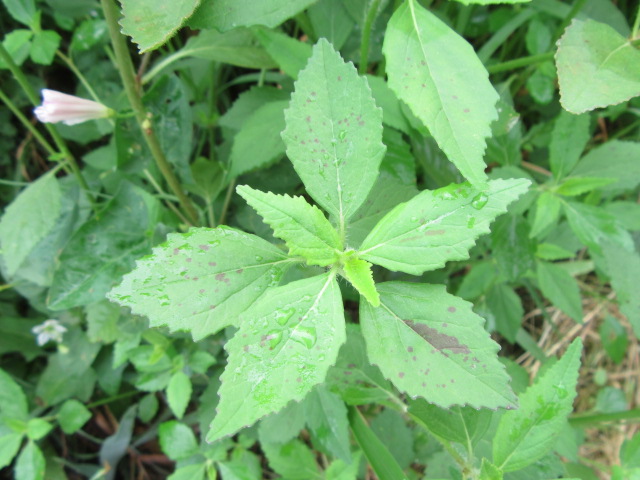
Euphorbia davidii (David’s Spurge) on 7-26-22, #901-20.
A lot of the leaves are SPOTTED! Hmmm… It is normal for there to be some maroon tinting on the leaves, but SPOTS?!?!?! I thought only Euphorbia davidii has spots plus the leaves are shaped more like E. dentata… After uploading the photos on the computer and giving them a good look, I realized some of the leaves looked a little iffy… Then I did the drag-and-drop thing on iNaturalist and the top suggestion, actually, the only suggestion, was Euphorbia davidii. GEEZ! That made me scratch my bald head! I wondered how in the heck could it figure that out from the first photo or even the second one? You can’t see spots. Honestly, I was wanting them to be Euphorbia dentata so I was trying to argue to prove my point. I have learned not to label the photos before I use iNaturalist because I think the algorithm can read… But, the more I wanted them to be E. dentata, the more I was beginning to see I was “possibly” mistaken. The leaves are somewhat more pointed than E. dentata, which are more bluntly pointed. Plus, the leaves of E. davidii are somewhat variable, more so than E. dentata.
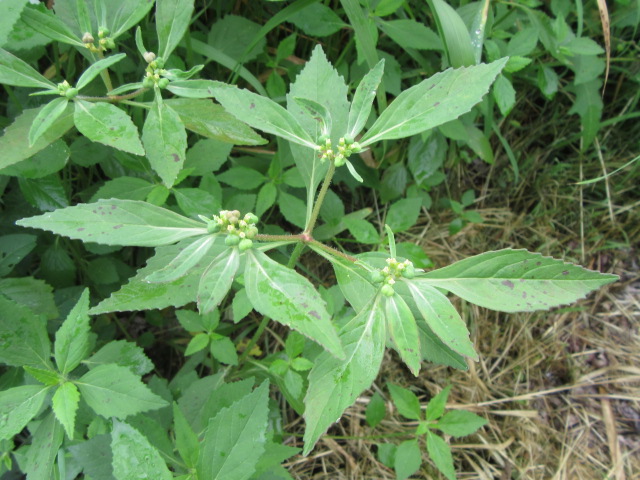
Euphorbia davidii (David’s Spurge) on 7-26-22, #901-21.
Look at this photo… I know I am new when it comes to Euphorbia davidii and E. dentata, but this is weird among plants… What was a cluster of flowers and fruit with a short pedicel separated into three and grew longer peduncles (flower stems). The flowers and fruit are on one side and the leaves are on the other. That is weird…
Apparently, Euphorbia dentata is a native of Argentina, northern Mexico, California, New Mexico, and Arizona. The species has moved all the way up to Idaho all the way to the east coast and up into Canada. It normally is found hit and miss in a few counties, but it seems once it gets started… I have been trimming the ditch since 2013 (when I moved back here) and never saw it until now. Well, if I disregard the plant I found in the basement of the old foundation last year I identified it as E. dentata. Now there is the huge colony along the park which I wrote about a couple of posts ago…
It was found in a couple of places in Europe 15 or so years ago and is considered an invasive weed in several countries there.
For now, Euphorbia davidii and E. dentata are neat plants to photograph and write about. Time will tell what happens in the future. Sometimes plants show up and then all of a sudden disappear. You just never know…
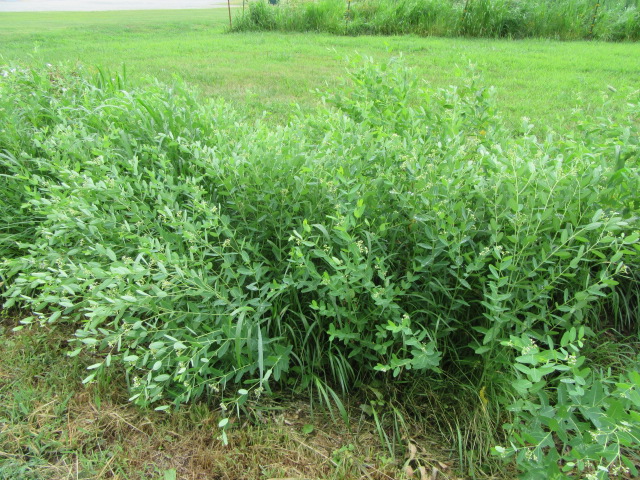
Apocynum cannabinum (Hemp Dogbane) in the ditch on 7-26-22, #901-7.
Here we go again! Of all the species on the farm, the Apocynum cannabinum (Hemp Dogbane) has definitely spread the quickest since I found the first plant in the hayfield in 2020. Oh, there are plenty of other plants with much larger numbers but they have been here forever. When the conditions are just right for several years in a row, they spread. Remember the Persicaria a few years ago when I identified seven species? They are still here but the colonies aren’t near as large. You never know what will come and go…
Honestly, I think I need to stop mentioning this species and taking their photos. I think it thinks I like it but too much of a good thing…
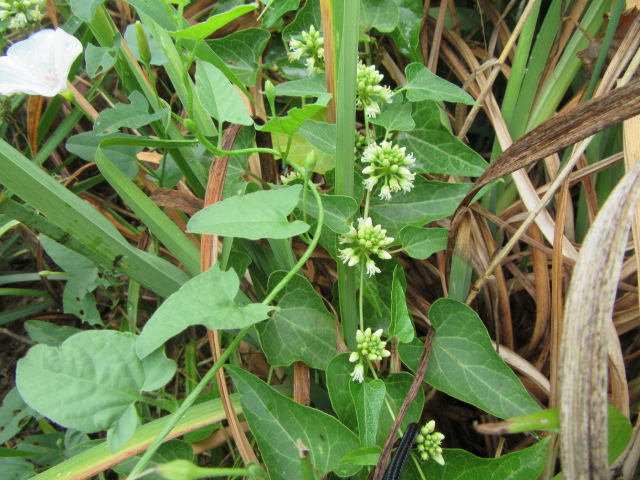
Ampelamus laevis (right) and Convolvulus arvensis (left) on 7-26-22
I remember many years ago when I was a kid morning glories would come up in the garden. They would twine up the sweet corn and anything else if allowed. I always liked their flowers. Here in the garden, they are always the first plants to come up within a day or so of tilling. One came up and climbed on the asparagus a few years ago, so I left it so I could get photos. Then I noticed a few climbing on the sweet corn, which I left as well. But, then they started blooming they were NOT morning glories… They turned out to be Cynanchum laeve commonly known as the Honey-Vine Climbing Milkweed. I could never get good photos of the flowers until now. I can now write a page for this species since I have more photos. 🙂
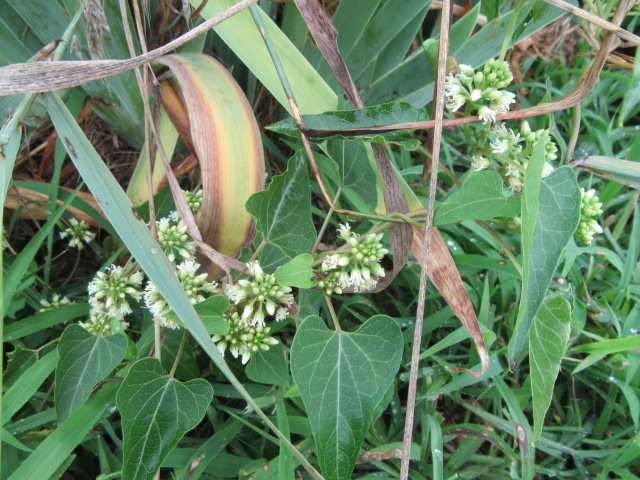
Ampelamus laevis (Honey-Vine Climbing Milkweed) on 7-26-22, #901-1.
They definitely have morning glory-looking leaves…
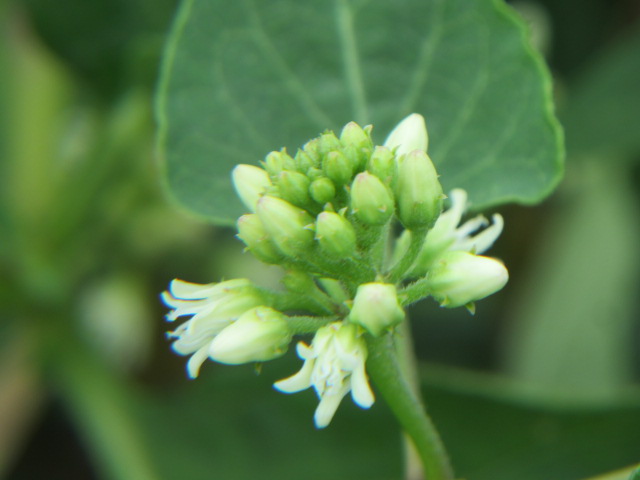
Ampelamus laevis (Honey-Vine Climbing Milkweed) on 7-26-22, #901-6.
But their flowers tell a different story…
Many websites use the scientific name Cynanchum laeve, including iNaturalist with Ampelamus laevis as a synonym. I am sticking with what Plants of the World Online says for now.
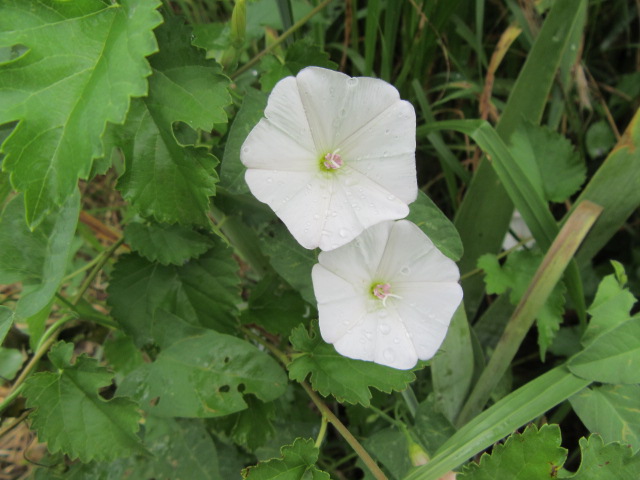
Convolvulus arvensis (Field Bindweed) on 7-26-22, #901-9.
The other morning glory-looking vine is Convolvulus arvensis (Field Bindweed). I first identified this species on a friend’s pasture in 2019. It has been growing in the ditch for a few years but I didn’t give it much thought. The flowers are either white to mostly pink…
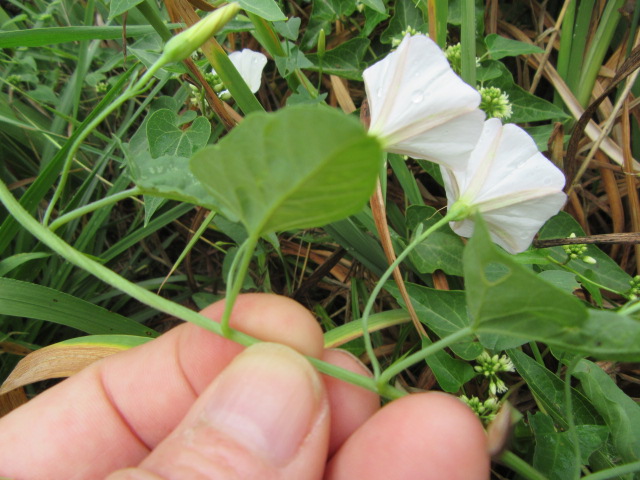
Convolvulus arvensis (Field Bindweed) on 7-26-22, #901-13.
The underside of the flowers is somewhat strange. When I first saw their flowers on Kevin’s farm, they appeared to have pink stripes on the petals. I haven’t found a website that mentions this feature, but from the underside, the center of the petals seems to have a “thicker” stripe that is sometimes pink. In bright light, the pink color shines through to the upper surface. With this species, mostly single flowers appear on long peduncles produced from the leaf bracts. Another look-alike produces mostly doubles…
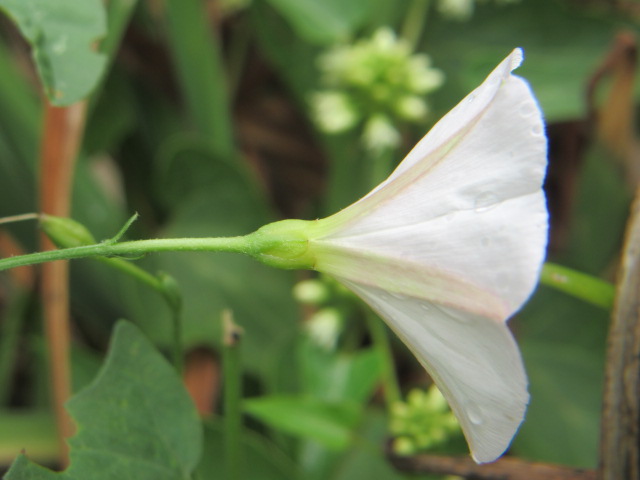
Convolvulus arvensis (Field Bindweed) on 7-26-22, #901-14.
From the above photo, you can see the calyx with five short sepals, the outer 3 being slightly shorter and narrower. Farther down the peduncle (flower stem) are a couple of bracts… These bracts fall off during the fruiting stage. In most species of plants, the bracts are part of the calyx…
I seem to be missing something…
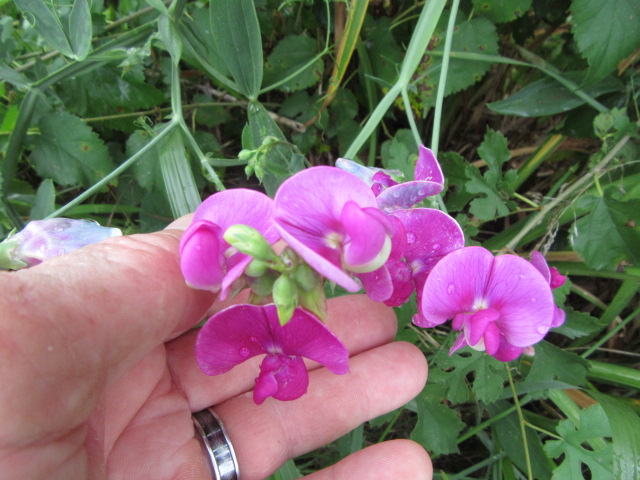
Lathyrus latifolius (Bread-Leaved Pea/Everlasting Pea) on 7-26-22, #901-26.
Oh yeah! The sweet peas! Well, that’s what we always called them when I was a kid. The Lathyrus latifolius has been growing here since I was a kid, and even on the fence where I grew up. There is quite a patch of them growing in the area north of the chicken house in varying shades or pink and white. This species is actually a European native that was imported as an ornamental. Other common names include Broad-Leaved Sweet Pea, Everlasting Pea, Wild Sweet Pea, Perennial Pea, Perennial Peavine, Everlasting Vetchling, and probably more.
The ditch is where a few of the daylilies also grow. They don’t normally produce many flowers, but like I mentioned in an earlier post, this has been a day lily year… Another patch in the shade and they rarely flower. There are A LOT of other species of “weeds” and grass in the ditch like the trumpet vine, Horse Nettle, etc. The ditch in front of the house has its own species, including Ruellia humilis (Wild Petunia).
I am not going to talk about the ditch in front of the pasture. It is a complete disaster. Well, there are some interesting plants there, too. For the most part, the sumac has gone mad with threats of a complete takeover. I guess it is doing that because of my threats…
Well, that’s it for now. I am still waiting for the Elephantopus carolinianus (Leafy Elephant’s Foot) and the two asters to flower in the back of the farm to flower… It’s almost August, for crying out loud, and they haven’t a single bud yet! I think possibly the New England Aster (Symphyotrichum novae-angliae) I found by the front pond last year may have come back. It is another late bloomer. I have been looking for it all summer, but it appeared they didn’t come up. Last week, I think I finally spotted it. I didn’t notice it until the end of September last summer when it was blooming… Keep your fingers crossed!
Until next time, be safe, stay positive, and always be thankful.